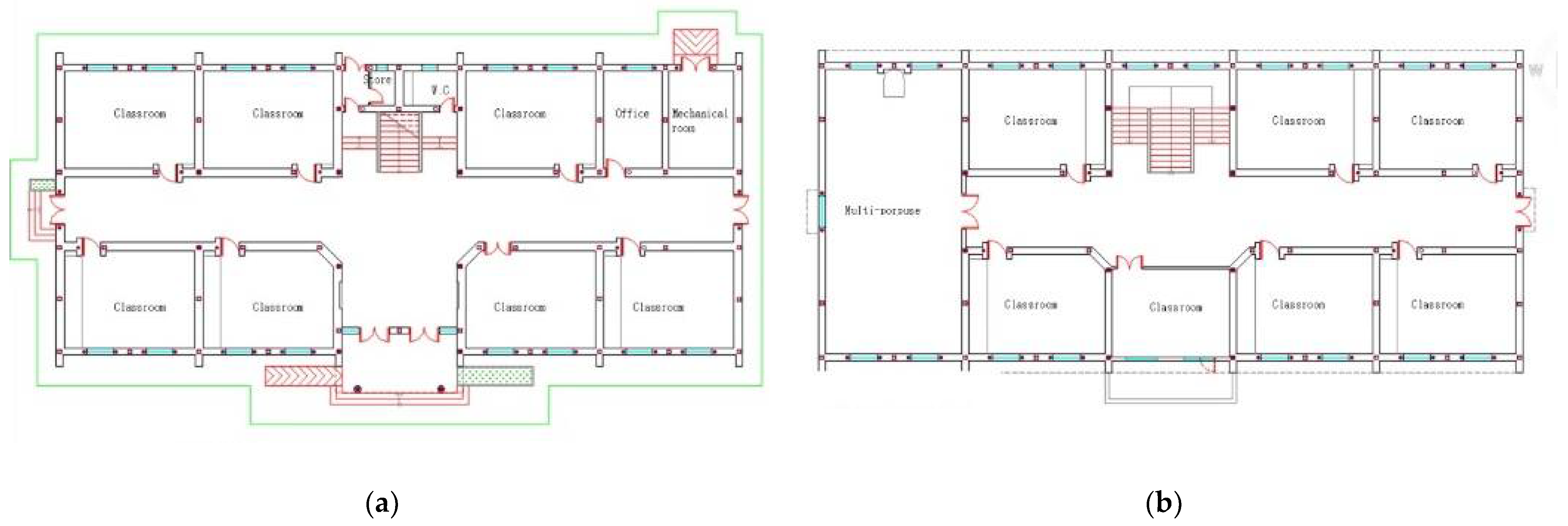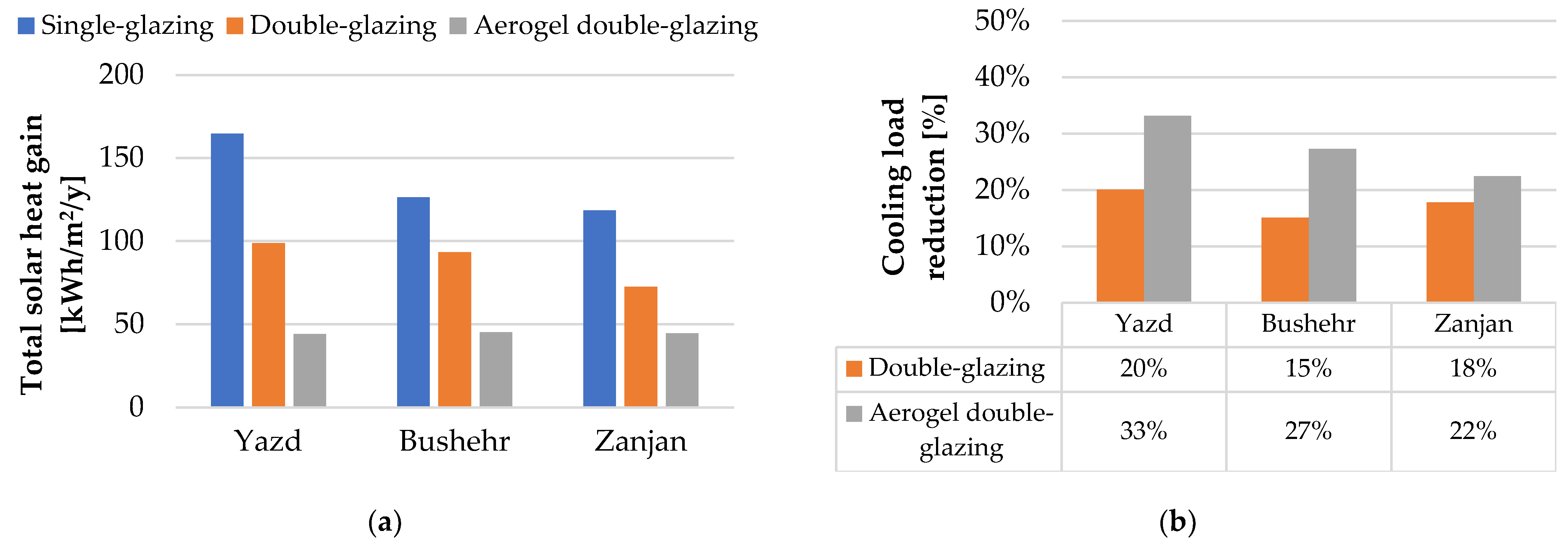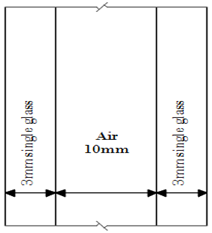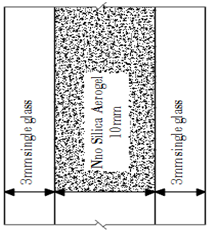Analysis of Nano Silica Aerogel Based Glazing Effect on the Solar Heat Gain and Cooling Load in a School under Different Climatic Conditions †
Abstract
:1. Introduction
2. Methodology
3. Results
4. Conclusions
- aerogel double-glazing system could be considered a good solution in terms of annual energy demand reduction with respect to simple glazing, under hot-dry climates (Yazd). The use of aerogel in Yazd has the highest decrease in solar gain (73% and 56% of reduction compared with single and double-glazing systems, respectively) and cooling load (33% and 16% of reduction compared with single and double-glazing systems, respectively) among the three investigated cities;
- in Bushehr, the solar gain is reduced by aerogel and double-glazing of about 64% and 26% respectively, compared to the simple-glazing layer; by reducing the U-value and SHGC the aerogel configuration is able to reduce solar gain and hence cooling load;
- in Zanjan, the solar gain is reduced by aerogel by 62% compared to a single-glazing pane. Also, the difference between aerogel and double-glazing systems in solar gain reduction is 39%. The use of a double-glazing solution reduces the cooling load by 18% with respect to the single-glazing pane, which is about 5% less than the aerogel.
Author Contributions
Funding
Institutional Review Board Statement
Informed Consent Statement
Data Availability Statement
Acknowledgments
Conflicts of Interest
References
- Iranian Fuel Conservation Organization. Modification of Energy Consumption Patterns in Schools and Offices; Iranian Fuel Conservation Organization: Tehran, Iran, 2009. [Google Scholar]
- Im, P.; Haberl, J. A survey of high-performance schools. In Proceedings of the Fifteenth Symposium on Improving Building Systems in Hot and Humid Climates, Orlando, FL, USA, 24–26 July 2006. [Google Scholar]
- Ihm, P.; Park, L.; Kararti, M.; Seo, D. Impact of window selection on the energy performance of residential buildings in South Korea. Energy Policy 2012, 44, 1–9. [Google Scholar] [CrossRef]
- McKinsey & Company. Pathways to a Low-Carbon Economy: Version 2 of the Global Greenhouse Gas Abatement Cost Curve; McKinsey & Company: London, UK, 2009. [Google Scholar]
- Huang, L. Feasibility Study of Using Silica Aerogel as Insulation for Buildings. Master’s Thesis, KTH School of Industrial Engineering and Management, Stockholm Sweden, 2012. [Google Scholar]
- Buratti, C.; Belloni, E.; Merli, F.; Zinzi, M. Aerogel glazing systems for building applications: A review. Energy Build. 2021, 231, 110587. [Google Scholar] [CrossRef]
- Sadineni, S.B.; Madala, S.; Boehm, R.F. Passive building energy savings: A review of building envelope components. Renew. Sustain. Energy Rev. 2011, 15, 3617–3631. [Google Scholar] [CrossRef]
- Jelle, B.P.; Hynd, A.; Gustavsen, A.; Arasteh, D.; Goudey, H.; Hart, R. Fenestration of today and tomorrow: A state-of-the-art review and future research opportunities. Sol. Energy Mater. Sol. Cells 2012, 96, 1–28. [Google Scholar] [CrossRef] [Green Version]
- Shaeri, J.; Yaghoubi, M.; Aliabedi, M.; Vakilinazhad, R. analysis of using nano aerogel glazing on solar heat gain and cooling load in an office at hot and dry, hot and humid, and cold climates of Iran. J. Solid Fluid Mech. 2018, 7, 209–221. [Google Scholar]


| Single-Glazing Pane | Double-Glazing System | Aerogel Glazing System |
|---|---|---|
 |  |  |
| SHGC = 0.74–0.87 U-value = 5.829 W/m2K | SHGC = 0.64–0.77 U-value = 2.976 W/m2K | SHGC = 0.35 U-value = 0.927 W/m2K |
| Material | Thickness [mm] | Cross Section | U-Value [W/(m2K)] | Rc-Value [(m2K)/W] | |
|---|---|---|---|---|---|
| External wall | Brickwork | 100 |  | 0.365 | 2.741 |
| Expanded polystyrene | 80 | ||||
| Concrete block | 200 | ||||
| Gypsum plasterboard | 15 | ||||
| Internal wall | Gypsum plasterboard | 25 |  | 1.716 | 0.583 |
| Concrete block | 200 | ||||
| Gypsum plasterboard | 25 | ||||
| Ceiling | Floor screed | 10 |  | 1.4 | 0.71 |
| Cast concrete | 300 | ||||
| Expanded polystyrene | 200 | ||||
| Ceiling tiles | 100 | ||||
| Roof | Asphalt | 5 |  | 0.766 | 1.305 |
| Expanded polystyrene | 40 | ||||
| Concrete | 300 | ||||
| Gypsum plasterboard | 15 |
Publisher’s Note: MDPI stays neutral with regard to jurisdictional claims in published maps and institutional affiliations. |
© 2022 by the authors. Licensee MDPI, Basel, Switzerland. This article is an open access article distributed under the terms and conditions of the Creative Commons Attribution (CC BY) license (https://creativecommons.org/licenses/by/4.0/).
Share and Cite
Buratti, C.; Belloni, E.; Merli, F.; Mastoori, M.; Sharifi, S.N.; Pignatta, G. Analysis of Nano Silica Aerogel Based Glazing Effect on the Solar Heat Gain and Cooling Load in a School under Different Climatic Conditions. Environ. Sci. Proc. 2021, 12, 15. https://doi.org/10.3390/environsciproc2021012015
Buratti C, Belloni E, Merli F, Mastoori M, Sharifi SN, Pignatta G. Analysis of Nano Silica Aerogel Based Glazing Effect on the Solar Heat Gain and Cooling Load in a School under Different Climatic Conditions. Environmental Sciences Proceedings. 2021; 12(1):15. https://doi.org/10.3390/environsciproc2021012015
Chicago/Turabian StyleBuratti, Cinzia, Elisa Belloni, Francesca Merli, Mehrangiz Mastoori, Seyede Najme Sharifi, and Gloria Pignatta. 2021. "Analysis of Nano Silica Aerogel Based Glazing Effect on the Solar Heat Gain and Cooling Load in a School under Different Climatic Conditions" Environmental Sciences Proceedings 12, no. 1: 15. https://doi.org/10.3390/environsciproc2021012015
APA StyleBuratti, C., Belloni, E., Merli, F., Mastoori, M., Sharifi, S. N., & Pignatta, G. (2021). Analysis of Nano Silica Aerogel Based Glazing Effect on the Solar Heat Gain and Cooling Load in a School under Different Climatic Conditions. Environmental Sciences Proceedings, 12(1), 15. https://doi.org/10.3390/environsciproc2021012015









